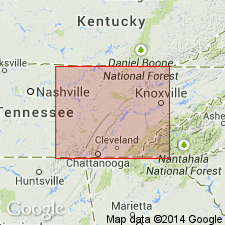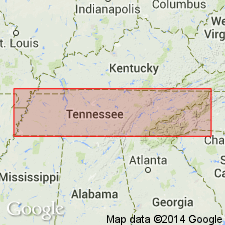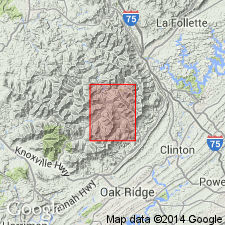
- Usage in publication:
-
- Graves Gap group
- Modifications:
-
- Original reference
- Dominant lithology:
-
- Sandstone
- Shale
- Coal
- AAPG geologic province:
-
- Appalachian basin
Summary:
Pg. 1, 11, 19, pls. 2, 3, 4, 6, 8. Graves Gap group. Includes all strata from top of Indian Bluff group (new) below to base of Redoak Mountain group (new) above; that is, between the top of the Pioneer sandstone and the top of the Windrock coal. In type section where Armes Gap sandstone (new) is thin and Roach Creek sandstone (new) is apparently absent, thickness of group is 365 feet; in Cross Mountain-Briceville-Graves Gap area, thickness averages 360 feet but elsewhere is 200 to 300 feet. Includes (ascending) shale interval, Armes Gap sandstone (new), and Windrock coal. Age is Early Pennsylvanian (Pottsville).
Type locality: Cross Mountain, Lake City quadrangle, Anderson Co., eastern TN. Section begins with top of Pioneer sandstone at Mountain View Church and ends at top of Windrock coal about 80 feet above Cumberland Mountain Church. Named from Graves Gap on State Highway 116 in southwestern part of quadrangle.
Source: US geologic names lexicon (USGS Bull. 1200, p. 1583).

- Usage in publication:
-
- Graves Gap Formation
- Modifications:
-
- [Revised]
- Mapped
- AAPG geologic province:
-
- Appalachian basin
Summary:
(East-central and East sheets.) Graves Gap Formation. Shale, sandstone, siltstone, and coal; from Windrock coal to top of Pioneer Sandstone Member of Indian Bluff Formation. Thickness 275 to 385 feet in east-central Tennessee; 200 to 350 feet in eastern Tennessee. Lies below Redoak Mountain Formation. Age is Pennsylvanian.
[The Graves Gap Group of Wilson and others (1956) is reduced to formation rank. Its constituent formations, the Roach Creek and Armes Gap, are also reduced in rank to members (not incl. on State geol. map). See also under Redoak Mountain.]
Source: Publication.

- Usage in publication:
-
- Graves Gap Formation
- Modifications:
-
- Overview
- Dominant lithology:
-
- Sandstone
- Shale
- Coal
- AAPG geologic province:
-
- Appalachian basin
Summary:
Consists of clayey to sandy, light-brown to dark-gray shale with coal beds and minor intercalated sandstone and siltstone; and yellowish-gray to yellowish-brown, fine- to medium-grained, thin-to thick-bedded sandstone, cross-bedded in part. Sandstones mostly lenticular. Marked at top by Windrock coal bed and a flint clay beneath it. Thickness ranges from 240 to 400 ft. Age is Middle Pennsylvanian.
Source: GNU records (USGS DDS-6; Reston GNULEX).
For more information, please contact Nancy Stamm, Geologic Names Committee Secretary.
Asterisk (*) indicates published by U.S. Geological Survey authors.
"No current usage" (†) implies that a name has been abandoned or has fallen into disuse. Former usage and, if known, replacement name given in parentheses ( ).
Slash (/) indicates name conflicts with nomenclatural guidelines (CSN, 1933; ACSN, 1961, 1970; NACSN, 1983, 2005, 2021). May be explained within brackets ([ ]).

